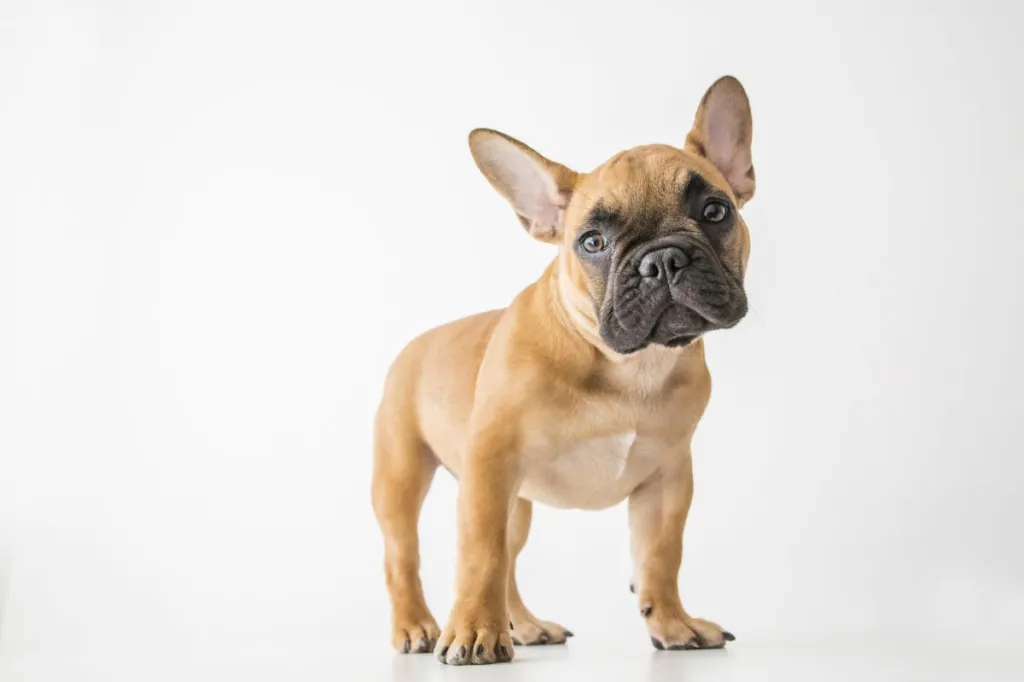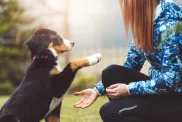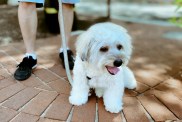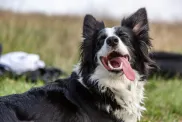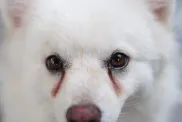The French Bulldog, with its unique charm and distinctive features, has become a beloved breed among dog enthusiasts. Originating in England, they were created as smaller versions of the Bulldog and were later brought to France by English lacemakers, where they gained their “Frenchie” moniker. Over the years, they have captured the hearts of many with their playful, adaptable, and affectionate nature.
French Bulldogs are instantly recognizable with their compact size, muscular build, and iconic bat-like ears. Their expressive faces, adorned with large, round eyes and a smushed nose, add to their undeniable appeal.
If you are looking for a small, friendly, and playful dog that is perfect for city living, then a Frenchie may be the perfect breed for you. French Bulldogs are relatively low-maintenance dogs that require only moderate exercise and grooming. They are also relatively healthy dogs, with few major health concerns.
Quick Facts
- Origin: France
- Size: Small, typically weighing around 16-28 pounds (7-13 kg)
- Lifespan: About 10-12 years
- Coat: Short and smooth coat, available in various colors such as brindle, fawn, white, and more.
- Temperament: French Bulldogs are known for their affectionate and easygoing nature. They are friendly, social, and often get along well with other pets and children.
- Exercise Needs: They have relatively low exercise requirements. Short walks and playtime are usually sufficient to keep them happy.
- Training: French Bulldogs can be somewhat stubborn, so training should be consistent and positive. They respond well to reward-based training methods.
- Grooming: Their short coat requires minimal grooming. Regular brushing can help keep their coat in good condition.
- Health: French Bulldogs are prone to certain health issues due to their brachycephalic (flat-faced) structure. Breathing difficulties, dental problems, and overheating in hot weather are common concerns. Regular veterinary care is essential.
- Frenchies became the United States’ most popular dog breed in 2023
Related: French Bulldog Puppies: Cute Pictures & Facts
French Bulldog Pictures
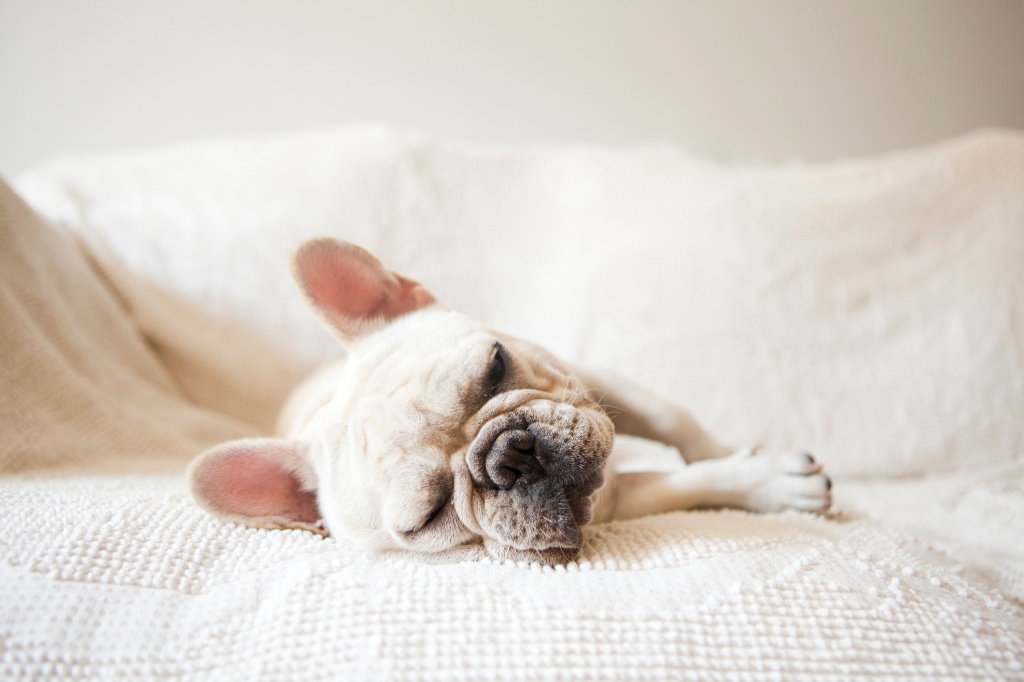
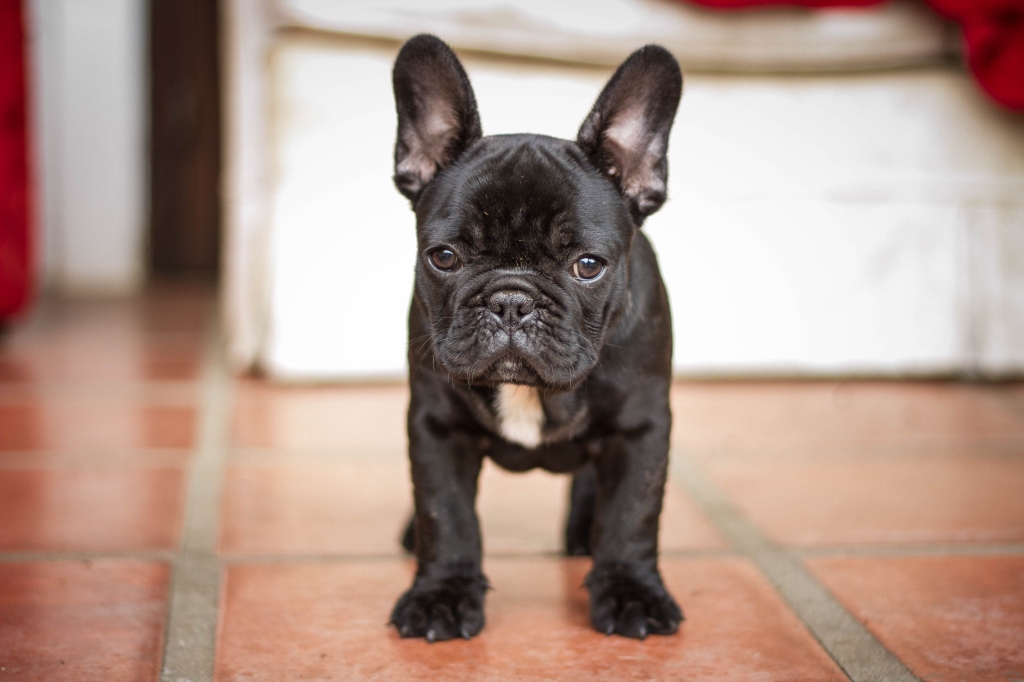
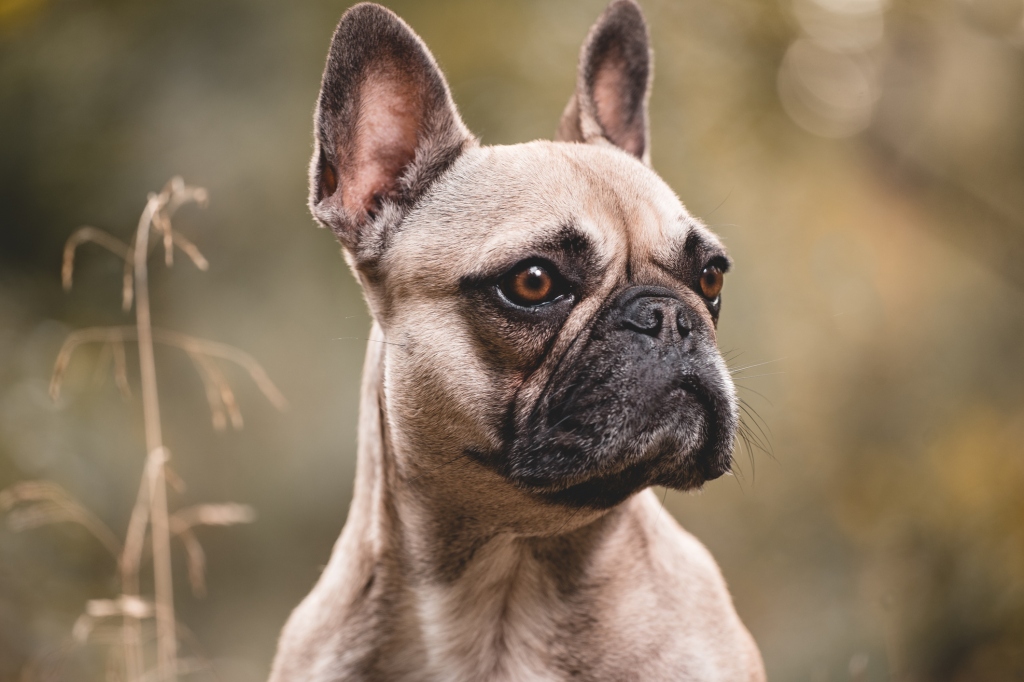
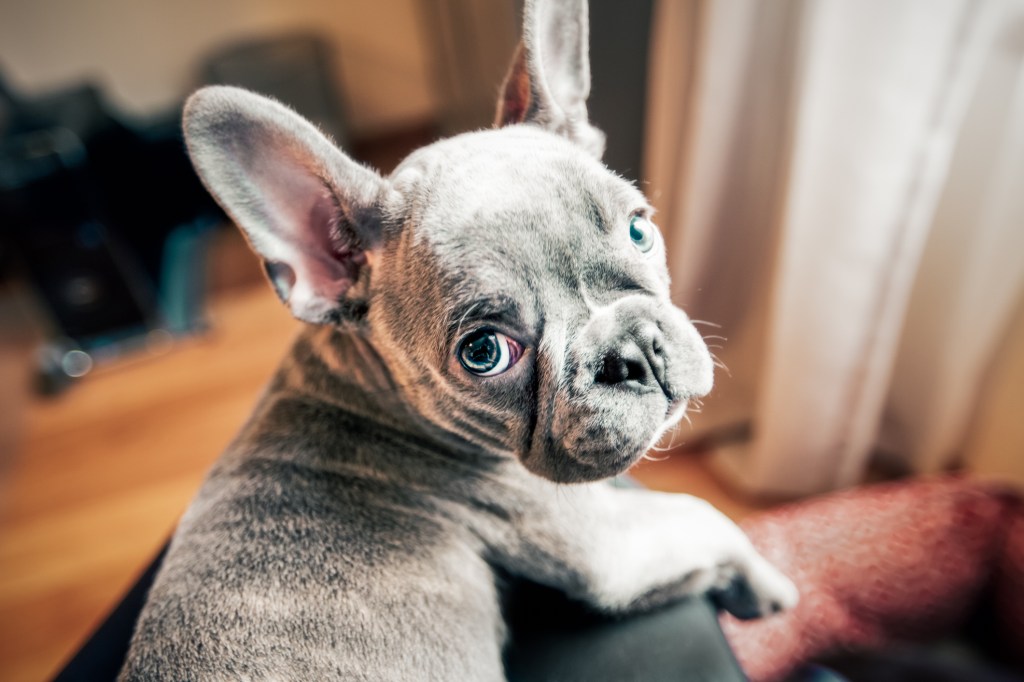
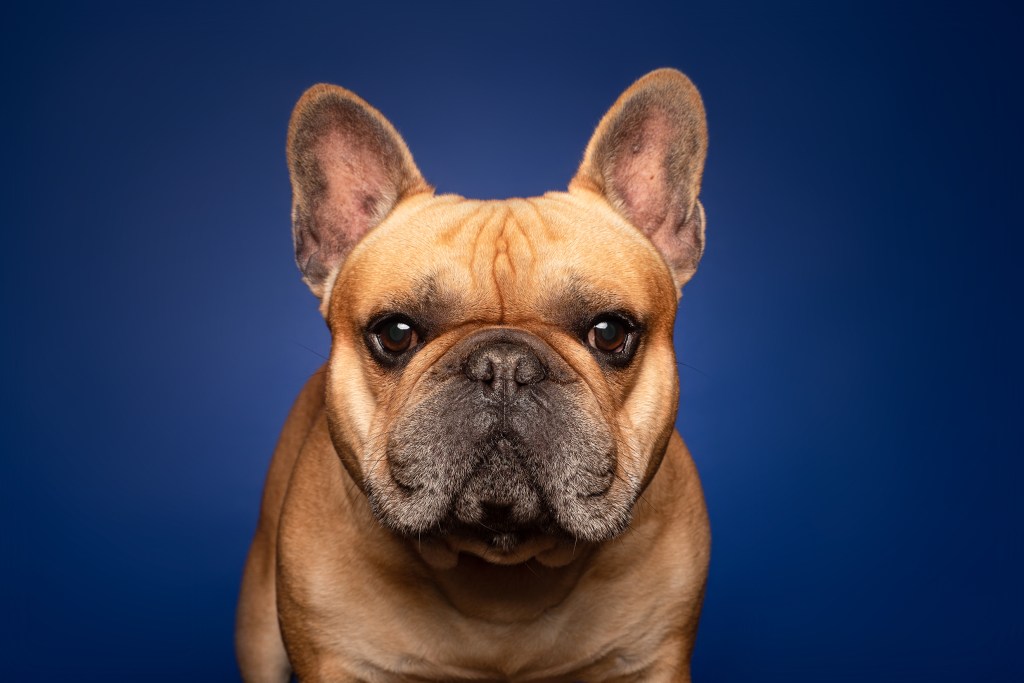
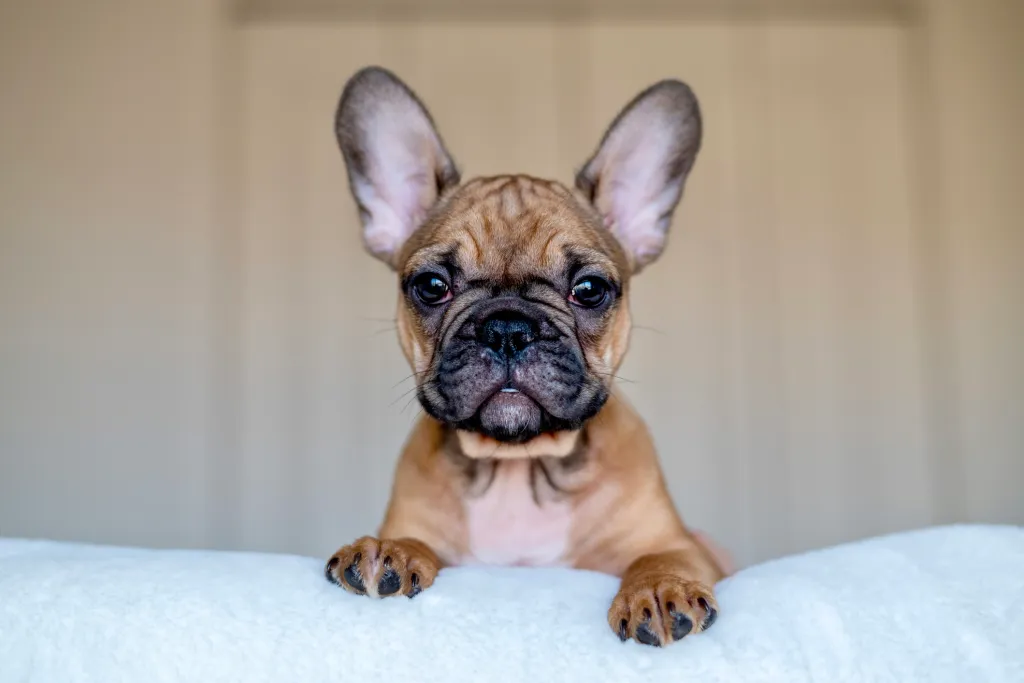
Adaptability
-
Adapts Well To Apartment Living
Looking for the best dog for your apartment? Contrary to popular belief, the suitability of dogs who adapt well to apartment living goes beyond its size. Apartment dwellers have a myriad of dog breeds to choose from as potential companions, with various factors to consider. Some large breeds can adapt well to apartment living and have lower activity levels. Others may require more space and possess higher energy levels. On the other hand, certain small dog breeds with abundant energy can still find contentment with indoor playtime or brisk walks.
However, when selecting a dog that adapts well apartments, it is essential to prioritize your neighbors. Opting for a pet that doesn’t excessively bark and behaves politely when encountering others in shared spaces like is crucial for maintaining a harmonious apartment environment.
In high-rise settings, it’s worth noting that numerous small dogs may exhibit a propensity for high energy and frequent barking. This makes them less suitable for apartment living. Therefore, desirable qualities in an apartment dog encompass being quiet, low-energy, and displaying polite behavior towards other residents.
Factors To Consider When Choosing A Dog For An Apartment
When considering dogs that adapt well to apartments, size alone should not be the sole determinant. Apartment dwellers have a wealth of dog breeds to choose from as potential furry companions. It’s important to remember that the size of your living space is just one factor to consider. While some larger breeds can adapt well to apartment living, with lower, others may require more space and have higher energy levels, making them less suitable for smaller apartments. Conversely, certain small dog breeds with higher energy levels can still thrive in apartments, finding contentment through indoor playtime or brisk walks. However, it is crucial to consider your neighbors’ comfort when selecting a dog. Opt for a pet that doesn’t bark excessively and behaves politely when interacting with others in shared spaces.
Therefore, it’s important to prioritize qualities such as being quiet, low-energy, calm indoors, and exhibiting good manners when living in close proximity to other residents. By considering these factors, you can find a dog that will adapt well to apartment living and create a harmonious living environment for everyone involved.
-
Good For Novice Owners
Some dogs are simply easier than others; they take to training better and are fairly easygoing. They’re also resilient enough to bounce back from your mistakes or inconsistencies.
Dogs who are highly sensitive, independent thinking, or assertive may be harder for a first-time dog parent to manage. You’ll get your best match if you take your dog-owning experience into account as you choose your new pooch.
If you’re new to dog parenting, take a look at 101 Dog Tricks and read up on how to train your dog!
-
Sensitivity Level
Some dogs will let a stern reprimand roll off their backs, while others take even a dirty look to heart. Low-sensitivity dogs, also called “easygoing,” “tolerant,” “resilient,” and even “thick-skinned,” can better handle a noisy, chaotic household, a louder or more assertive owner, and an inconsistent or variable routine. Do you have young kids, throw lots of dinner parties, play in a garage band, or lead a hectic life? Go with a low-sensitivity dog.
-
Tolerates Being Alone
Some breeds bond very closely with their family and are more prone to worry or even panic when left alone by their owner. An anxious dog can be very destructive–barking, whining, chewing, and otherwise causing mayhem. These breeds do best when a family member is home during the day or if you can take the dog to work.
-
Tolerates Cold Weather
Breeds with very short coats and little or no undercoat or body fat, such as Greyhounds, are vulnerable to the cold. Dogs with a low cold tolerance need to live inside in cool climates and should have a jacket or sweater for chilly walks. You can find a great jacket for your dog here!
-
Tolerates Hot Weather
Dogs with thick, double coats are more vulnerable to overheating. So are breeds with short noses, like Bulldogs or Pugs, since they can’t pant as well to cool themselves off. If you want a heat-sensitive breed, your dog will need to stay indoors with you on warm or humid days, and you’ll need to be extra cautious about exercising your dog in the heat.
All-around friendliness
-
Affectionate With Family
When it comes to unconditional love and unwavering loyalty, few animals can rival the affectionate nature of dogs. These remarkable creatures have earned their reputation as man’s best friend, and many breeds are particularly renowned for their love and devotion to their families. With their warm hearts and wagging tails, affectionate family dogs enrich the lives of their owners in countless ways.
One such breed known for its affectionate demeanor is the Golden Retriever. With their gentle temperament and friendly disposition, Golden Retrievers form deep bonds with their families. They eagerly participate in family activities, whether it’s a game of fetch in the yard or cuddling on the couch during a movie night. Their expressive eyes and ever-wagging tails are a testament to the joy they feel in the presence of their loved ones.
Another family-favorite breed is the Labrador Retriever. Renowned for their playful and patient nature, Labradors are excellent companions for children and adults alike. They readily engage in playtime with the kids, showcasing their boundless energy and enthusiasm. But when the day winds down, they seamlessly transition into loving and gentle cuddle buddies, comforting their family members with their warm presence.
Beyond specific breeds, mixed-breed dogs also have a special place in the hearts of families seeking affectionate companions. The shelter dogs, in particular, form deep connections with their adoptive families. They seem to understand the second chance they’ve been given and repay it with endless love and gratitude.
How To Know If A Dog Is Good With Families
The affectionate nature of family dogs extends beyond play and cuddles. Dogs have a remarkable ability to sense their owner’s emotions, offering comfort and support during difficult times. Whether it’s a wagging tail after a long day at work or a sympathetic nuzzle during moments of sadness, they prove time and again that they are attuned to their family’s needs.
It is important to note that not all dogs of the same breed will be equally affectionate. Some dogs may be more independent or aloof, while others may be more clingy or demanding of attention. The best way to find out how affectionate a dog is is to meet them in person and interact with them.
-
Kid-Friendly
Being gentle with children, sturdy enough to handle the heavy-handed pets and hugs they can dish out, and having a blasé attitude toward running, screaming children are all traits that make a kid-friendly dog. You may be surprised by who’s on that list: Fierce-looking Boxers are considered good with children, as are American Staffordshire Terriers (which are considered Pit Bulls). Small, delicate, and potentially snappy dogs such as Chihuahuas aren’t always so family-friendly.
**All dogs are individuals. Our ratings are generalizations, and they’re not a guarantee of how any breed or individual dog will behave. Dogs from any breed can be good with children based on their past experiences, training on how to get along with kids, and personality. No matter what the breed or breed type, all dogs have strong jaws, sharp pointy teeth, and may bite in stressful circumstances. Young children and dogs of any breed should always be supervised by an adult and never left alone together, period.
-
Dog Friendly
Friendliness toward dogs and friendliness toward humans are two completely different things. Some dogs may attack or try to dominate other dogs, even if they’re love-bugs with people; others would rather play than fight; and some will turn tail and run. Breed isn’t the only factor. Dogs who lived with their littermates and mother until at least six to eight weeks of age and who spent lots of time playing with other dogs during puppyhood, are more likely to have good canine social skills.
-
Friendly Toward Strangers
Stranger-friendly dogs will greet guests with wagging tails and nuzzles; others are shy, indifferent, or even aggressive. However, no matter what the breed, a dog who was socialized and exposed to lots of different types, ages, sizes, and shapes of people as a puppy will respond better to strangers as an adult. Remember that even friendly dogs should stay on a good, strong leash like this one in public!
Health And Grooming Needs
-
Amount Of Shedding
If you’re going to share your home with a dog, you’ll need to deal with some level of dog hair on your clothes and in your house. However, shedding does vary greatly among the breeds. Some dogs shed year-round, some “blow” seasonally, some do both, and some shed hardly at all. If you’re a neatnik, you’ll need to either pick a low-shedding breed or relax your standards. To help keep your home a little cleaner, you can find a great de-shedding tool here!
-
Drooling Potential
Drool-prone dogs may drape ropes of slobber on your arm and leave big, wet spots on your clothes when they come over to say hello. If you’ve got a laid-back attitude toward slobber, fine; but if you’re a neatnik, you may want to choose a dog who rates low in the drool department.
-
Easy To Groom
Some breeds are brush-and-go dogs; others require regular bathing, clipping, and other grooming just to stay clean and healthy. Consider whether you have the time and patience for a dog who needs a lot of grooming, or the money to pay someone else to do it.
-
General Health
Due to poor breeding practices, some breeds are prone to certain genetic health problems, such as hip dysplasia. This doesn’t mean that every dog of that breed will develop those diseases; it just means that they’re at an increased risk.
If you’re adopting a puppy, it’s a good idea to find out which genetic illnesses are common to the breed you’re interested in. You may also want to ask if your shelter or rescue has information about the physical health of your potential pup’s parents and other relatives.
-
Potential For Weight Gain
Some breeds have hearty appetites and tend to put on weight easily. As in humans, being overweight can cause health problems in dogs. If you pick a breed that’s prone to packing on pounds, you’ll need to limit treats, make sure they get enough exercise, and measure out their daily food servings into regular meals rather than leaving food out all the time.
Ask your vet about your dog’s diet and what they recommend for feeding your pooch to keep them at a healthy weight. Weight gain can lead to other health issues or worsen problems like arthritis.
-
Size
Get ready to meet the giants of the doggy world! Large dog breeds aren’t just big balls of fluff, they’re like loving, oversized teddy bears on a mission to steal your heart. Need some convincing? Let’s dive into the awesome benefits of owning one!
First things first, these pooches are a living security system! With their impressive size and thunderous barks, they’ll have any would-be intruder running for the hills. Talk about peace of mind! Plus, who needs an alarm when you’ve got a furry giant protecting your castle?
But that’s not all. Large dog breeds are all about loyalty and devotion. They’ll stick by your side through thick and thin, becoming your most dedicated bestie. Their love knows no bounds! When you have a giant fluffball showing you unconditional love, you’ll feel like the luckiest human on the planet.
Now, let’s talk about their talents. These big fellas are the ultimate working partners. With brains and brawn, they’re up for any challenge. From search and rescue missions to lending a helping paw to those in need, these dogs are superheroes in fur coats. They’ll make you proud every step of the way!
Don’t let their size fool you—these gentle giants have hearts as big as their paws. They’re incredible with kids and other pets, spreading their love like confetti. Their patience and kindness make them perfect family pets, ensuring harmony in your household.
Oh, and get ready to break a sweat! These dogs are fitness enthusiasts, and they’ll keep you on your toes. Daily walks, jogs, and play sessions will not only keep them happy and healthy but will also give you a reason to ditch the couch and join in on the fun. It’s a win-win situation!
So, if you’re ready for a dose of big love, go ahead and consider a large dog breed. They’re the best wing-dog you could ever ask for, ready to make your life a thousand times more exciting, loving, and downright awesome! Get ready for the big adventure of a lifetime!
Trainability
-
Easy To Train
Easy-to-train dogs are more adept at forming an association between a prompt (such as the word “sit”), an action (sitting), and a consequence (getting a treat) very quickly. Other dogs need more time, patience, and repetition during training.
Many breeds are intelligent but approach training with a “What’s in it for me?” attitude, in which case you’ll need to use rewards and games to teach them to want to comply with your requests.
Related:
10 Fun, Impressive Tricks You Can Teach Any Dog
-
Intelligence
Dogs who were bred for jobs that require decision making, intelligence, and concentration, such as herding livestock, need to exercise their brains, just as dogs who were bred to run all day need to exercise their bodies. If they don’t get the mental stimulation they need, they’ll make their own work–usually with projects you won’t like, such as digging and chewing. Obedience training and interactive dog toys are good ways to give a dog a brain workout, as are dog sports and careers, such as agility and search and rescue.
-
Potential For Mouthiness
Common in most breeds during puppyhood and in Retriever breeds at all ages, mouthiness means a tendency to nip, chew, and play-bite (a soft, fairly painless bite that doesn’t puncture the skin). Mouthy dogs are more likely to use their mouths to hold or “herd” their human family members, and they need training to learn that it’s fine to gnaw on chew toys, but not on people. Mouthy breeds tend to really enjoy a game of fetch, as well as a good chew on a toy that’s been stuffed with kibble and treats.
-
Prey Drive
Dogs with a high prey drive have an instinctive desire to stalk, capture, and prey upon potential food sources. Dogs who were bred to hunt, such as Terriers, have an inborn desire to chase — and sometimes kill — other animals. Anything whizzing by — such as cats, squirrels, and perhaps even cars — can trigger that instinct.
How to address a high prey drive
Off-leash adventures are too great a temptation for pups who will wander and hunt. Dogs who like to chase need to be leashed. And, even on a leash, you may experience your dog pulling on the leash to reach rodents or birds in their sight. Otherwise, these pups should be kept in a fenced area when outdoors. If your pup has a high prey drive, you’ll need a high, secure fence in your yard.
These breeds generally aren’t a good fit for homes with smaller pets that can look like prey, such as cats, hamsters, or small dogs. Breeds that were originally used for bird hunting, on the other hand, generally won’t chase, but you’ll probably have a hard time getting their attention when there are birds flying by.
Other behavioral concerns
Observing your dog’s prey drive, which is instinctual and biologically-rooted, is not the same as observing aggression. Much aggression is born of fear and anxiety, especially in the case of dog aggression toward humans.
The tendency to wander, even into oncoming traffic, can produce diasterious results for pups with predatory instincts. It can also lead to pups being bitten by snakes or attacked by other wild animals they may pursue while on the hunt.
-
Tendency To Bark Or Howl
Some breeds sound off more often than others. When choosing a breed, think about how often the dog vocalizes. Learn more about breeds with a tendency to bark or howl.
If you’re considering a hound, would you find their trademark howls musical or maddening? If you’re considering a watchdog, will a city full of suspicious “strangers” put your pup on permanent alert? Will the local wildlife literally drive your dog wild? Do you live in housing with noise restrictions? Do you have neighbors nearby? Then you may wish to choose a quieter dog.
-
Wanderlust Potential
Some breeds are more free-spirited than others. Nordic dogs such as Siberian Huskies were bred to range long distances, and given the chance, they’ll take off after anything that catches their interest. And many hounds simply must follow their noses–or that bunny that just ran across the path–even if it means leaving you behind.
Exercise needs
-
Energy Level
High-energy dogs are always ready and waiting for action. Originally bred to perform a canine job of some sort, such as retrieving game for hunters or herding livestock, they have the stamina to put in a full workday. They need a significant amount of exercise and mental stimulation, and they’re more likely to spend time jumping, playing, and investigating any new sights and smells.
Low-energy dogs are the canine equivalent of a couch potato, content to doze the day away. When picking a breed, consider your own activity level and lifestyle, and think about whether you’ll find a frisky, energetic dog invigorating or annoying.
-
Intensity
A vigorous dog may or may not have high energy, but everything they do, they do with vigor: they strain on the leash (until you train them not to), try to plow through obstacles, and even eats and drinks with great big gulps. These dynamos need lots of training to learn good manners, and may not be the best fit for a home with young kids or someone who’s elderly or frail. A low-vigor dog, on the other hand, has a more subdued approach to life.
-
Exercise Needs
Some breeds do fine with a slow evening stroll around the block. Others need daily, vigorous exercise, especially those that were originally bred for physically demanding jobs, like herding or hunting.
Without enough exercise, these breeds may put on weight and vent their pent-up energy in ways you don’t like, such as barking, chewing, and digging. Breeds that need a lot of exercise are good for outdoorsy, active people, or those interested in training their dog to compete in a high-energy dog sport, such as agility.
-
Potential For Playfulness
Some dogs are perpetual puppies — always begging for a game — while others are more serious and sedate. Although a playful pup sounds endearing, consider how many games of fetch or tag you want to play each day, and whether you have kids or other dogs who can stand in as playmates for the dog.
French Bulldog Overview
Bat-eared but oddly beautiful, the French Bulldog has a unique appeal. Aesthetically, other breeds undeniably are more glamorous and showy, but beauty is in the eye of the beholder and what many behold in the French Bulldog are the attributes that make this breed one of the best companion dogs in the world today.
The French Bulldog is small but substantial in build with a powerful muscular body. He sports a short easy-care coat to accompany his easygoing personality. The Frenchie likes to play, but he also enjoys spending his days relaxing on the sofa. That love of play and relaxed attitude carry over into their training sessions. French Bulldogs are intelligent, and training them is easy as long as you make it seem like a game and keep it fun.
They are free thinkers and are not an ideal breed for competing in obedience or agility although some have risen to the challenge. This freethinking approach can also lead to a stubborn nature, and if they decide to dig in their heels there is no budging them. Frenchies are loving companions who thrive on human contact. If you want an outdoor dog who can be left alone for long periods, the Frenchie is not the breed for you.
This is a dog who enjoys lavishing love on his human companions as much as he loves the same treatment in return. They generally get along well with everyone, including children. They can, however, be territorial and possessive of their people, especially in the presence of other dogs.
Socialization is a must for this breed, but with their easy companionship this is an enjoyable task. With a nature that is both humorous and mischievous, the French Bulldog needs to live with someone who is consistent, firm, and patient with all the antics and idiosyncrasies that make him both frustrating and delightful. French Bulldogs make excellent watchdogs and will alert their people to approaching strangers, but it’s not their style to bark without cause. They can be protective of their home and family and some will try to defend both with their life.
French Bulldogs do not need a lot of room and do very well in apartments or small dwellings. A couple of 15-minute walks per day should keep them from becoming overweight. Keep the Frenchie in cool, comfortable surroundings. He’s susceptible to heat exhaustion and needs an air-conditioned environment. This is not a dog who can stay outside on a hot day. French Bulldogs are wonderful companion dogs with a gentle nature. If you work at home, the Frenchie is happy to lie at your feet all day or follow you from room to room. People who love them describe them as mischievous goof balls and can’t imagine life without them. They are a constant presence, and they’ll love you with all the strength in their small bodies, proving time and again that beauty is on the inside.
French Bulldog Highlights
- Friendly and playful: French Bulldogs are known for their friendly and playful personality. They love to cuddle and play fetch.
- Low-maintenance: French Bulldogs are relatively low-maintenance dogs. They only require moderate exercise and grooming.
- Good with children: French Bulldogs are good with children and other pets. They make great family dogs.
- Intelligent: French Bulldogs are intelligent dogs and can be easily trained.
- Adaptable: French Bulldogs can adapt to different living conditions. They are a good choice for apartment dwellers or people with active lifestyles.
- Healthy: French Bulldogs are generally healthy dogs, but they are prone to some health problems, such as brachycephalic airway syndrome and cherry eye.
Overall, French Bulldogs are great dogs for people of all ages and lifestyles. They are friendly, playful, and low-maintenance, making them a perfect addition to any family.
French Bulldog History
French Bulldogs originated in England in the 1800s as working dogs. They were originally bred to be bull-baiting dogs, but this practice was outlawed in England in 1835. French Bulldogs were then imported to France where they became popular as companion dogs.
In France, French Bulldogs were often kept by lacemakers and other artisans who worked in small shops. The dogs were prized for their gentle nature and their ability to adapt to cramped living quarters. French Bulldogs also became popular with the French upper class, and they were often depicted in paintings and sculptures.
French Bulldogs were first brought to the United States in the late 1800s, and they quickly became popular with American families. The dogs were known for their friendly and playful personality, and they made great companions for children. French Bulldogs also became popular with celebrities, and they were often featured in movies and television shows.
Today, French Bulldogs are one of the most popular dog breeds in the United States. They are known for their friendly and playful personality, their low-maintenance coat, and their adaptability to different living conditions. French Bulldogs make great companions for people of all ages and lifestyles.
The French Bulldog thrived in France and Europe, and his charm was soon discovered by Americans as well. The United States saw its first French Bulldog at the Westminster Kennel Club show in 1896. The breed was quickly nicknamed “Frenchie,” and it is still an affectionate name that is used today.
French Bulldog Size
Generally a French Bulldog is about 11 to 12 inches tall. Males weigh 20 to 28 pounds, females 16 to 24 pounds.
French Bulldog Personality
This is a smart, loving dog who wants and needs to spend lots of time with his people. A fun-loving freethinker, the French Bulldog takes well to training when it’s done in a positive manner with lots of food rewards, praise, and play.
French Bulldog Health
Not all Frenchies will get any or all of these diseases, but it’s important to be aware of them if you’re considering this breed.
- Hip Dysplasia: Hip dyplasia is a heritable condition in which the femur doesn’t fit snugly into the pelvic socket of the hip joint. Hip dysplasia can exist with or without clinical signs. Some dogs exhibit pain and lameness on one or both rear legs. As the dog ages, arthritis can develop. X-ray screening for hip dysplasia is done by the Orthopedic Foundation for Animals or the University of Pennsylvania Hip Improvement Program. Dogs with hip dysplasia should not be bred. Ask the breeder for proof that the parents have been tested for hip dysplasia and found to be free of problems.
- Brachycephalic Syndrome: This disorder is found in dogs with short heads, narrowed nostrils, or elongated or soft palates. Their airways are obstructed to varying degrees and can cause anything from noisy or labored breathing to total collapse of the airway. Dogs with brachycephalic syndrome commonly snuffle and snort. Treatment varies depending on the severity of the condition but includes oxygen therapy as well as surgery to widen nostrils or shorten palates.
- Allergies: Allergies are a common problem in dogs. There are three main types of allergies: food-based allergies, which are treated by an elimination process of certain foods from the dog’s diet; contact allergies, caused by a reaction to a topical substance such as bedding, flea powders, dog shampoos, and other chemicals, and treated by removing the cause of the allergy; and inhalant allergies, caused by airborne allergens such as pollen, dust, and mildew. The medication for inhalant allergies depends on the severity of the allergy. It is important to note that ear infections often accompany inhalant allergies.
- Hemivertebrae: This is a malformation of one or more vertebrae that causes it to be shaped like a wedge or triangle. This malformation can occur on its own or with other vertebrae malformations. Hemivertebra can cause no problems, or it can put pressure on the spinal cord. This can lead to pain, weakness, and or paralysis. There is no treatment for the condition unless there is spinal cord pressure.
- Patellar Luxation: Also known as “slipped stifles,” this is a common problem in small dogs. It is caused when the patella, which has three parts — the femur (thigh bone), patella (knee cap), and tibia (calf) — is not properly lined up and slips in and out of place (luxates). This causes lameness or an abnormal gait (the way the dog moves). It is a congenital disease, meaning it’s present at birth, although the actual misalignment or luxation does not always occur until much later. The rubbing caused by patellar luxation can lead to arthritis, a degenerative joint disease. There are four grades of patellar luxation ranging from grade I, an occasional luxation causing temporary lameness in the joint, to grade IV, in which the turning of the tibia is severe and the patella cannot be realigned manually. This gives the dog a bowlegged appearance. Severe grades of patellar luxation may require surgical repair.
- Intervertebral Disc Disease (IVDD): IDD occurs when a disc in the spine ruptures or herniates and pushes upward into the spinal cord. When the disc pushes into the spinal cord, nerve transmissions are inhibited from traveling along the spinal cord. Intervertebral Disc Disease can be caused by trauma, age, or simply from the physical jolt that occurs when a dog jumps off a sofa. When the disc ruptures, the dog usually feels pain and the ruptured disc can lead to weakness and temporary or permanent paralysis. Treatment usually involves nonsteroidal anti-inflammatory drugs (NSAIDS) made specially for dogs. Never give your dog Tylenol or other NSAIDs made for people as they can be toxic. In some cases surgery can help, but it must be done within a day or so of the injury. You may also want to ask your veterinarian about physical rehabilitation. Treatments such as massage, water treadmills and electrical stimulation are available for dogs and can have excellent success.
- Von Willebrand’s Disease: This is a blood disorder that can be found in both humans and dogs. It affects the clotting process due to the reduction of von Willebrand factor in the blood. A dog affected by von Willebrand’s disease will have signs such as nose bleeds, bleeding gums, prolonged bleeding from surgery, and prolonged bleeding during heat cycles or after whelping. Occasionally blood is found in the stool. This disorder is usually diagnosed in your dog between the ages of 3 and 5 and cannot be cured. However, it can be managed with treatments that include cauterizing or suturing injuries, transfusions of the von Willebrand factor before surgery, and avoiding certain medications.
- Cleft Palate: The palate is the roof of the mouth and separates the nasal and oral cavities. It is made up of two parts, hard and soft. A cleft palate has a slit that runs bilaterally or unilaterally and can range in size from a small hole to a large slit. A cleft palate can affect both the hard and soft palate separately and together and may cause a cleft lip. Puppies can be born with cleft palates, or a cleft palate can occur from an injury. Cleft palates are fairly common in dogs, but many puppies born with a cleft palate do not survive or are euthanized by the breeder. The only treatment for a cleft palate is surgery to close the hole, although not all dogs with a cleft palate require the surgery. It is important to get a diagnosis and treatment recommendation from your veterinarian.
- Elongated Soft Palate: The soft palate is the extension of the roof of the mouth. When the soft palate is elongated, it can obstruct airways and cause difficulty in breathing. The treatment for Elongated Soft Palate is surgical removal of the excess palate.
If you’re buying a puppy, find a good breeder who will show you health clearances for both your puppy’s parents. Health clearances prove that a dog has been tested for and cleared of a particular condition.
In Frenchies, you should expect to see health clearances from the Orthopedic Foundation for Animals (OFA) for hip dysplasia (with a score of fair or better), elbow dysplasia, hypothyroidism, and von Willebrand’s disease; from Auburn University for thrombopathia; and from the Canine Eye Registry Foundation (CERF) certifying that eyes are normal. You can confirm health clearances by checking the OFA web site (offa.org). Regardless of how healthy your dog is when you first bring them home, you should prepare for any issues that may come up throughout their life.
French Bulldog Care
French Bulldogs do not need a lot of exercise. They have fairly low energy levels, although there are exceptions to every rule. To keep their weight down, however, they need daily exercise through short walks or play times in the yard.
Many French Bulldogs enjoy playing and will spend much of their time in various activities, but they are not so high energy that they need a large yard or long periods of exercise. This breed is prone to heat exhaustion and should not be exercised in hot temperatures. Limit walks and active play to cool mornings and evenings.
When training a French Bulldog, take into account that although they are intelligent and usually eager to please, they are also free thinkers. That means they can be stubborn. Many different training techniques are successful with this breed, so don’t give up if a certain method doesn’t work; just try a different technique.
To pique your Frenchie’s interest, try to make training seem like a game with lots of fun and prizes. It is important to crate train your French Bulldog puppy even if you plan to give him the freedom of the house when he reaches adulthood. Regardless of breed, puppies explore, get into things they shouldn’t, and chew things that can harm them. It can be expensive both to repair or replace destroyed items and to pay the vet bills that could arise, so crate training benefits your wallet and your temper as well as your puppy’s well being.
French Bulldog Feeding
Recommended daily amount: 1 to 1.5 cups of high-quality dry food a day, divided into two meals. NOTE: How much your adult dog eats depends on his size, age, build, metabolism, and activity level. Dogs are individuals, just like people, and they don’t all need the same amount of food. It almost goes without saying that a highly active dog will need more than a couch potato dog.
The quality of dog food you buy also makes a difference — the better the dog food, the further it will go toward nourishing your dog and the less of it you’ll need to shake into your dog’s bowl. For more on feeding your Frenchie, see our guidelines for buying the right food, feeding your puppy, and feeding your adult dog .
French Bulldog Coat Color And Grooming
The coat of the French Bulldog is short, smooth, shiny, and fine. The skin is loose and wrinkled, especially at the head and shoulders, and has a soft texture. French Bulldogs come in a variety of colors, including fawn, cream, various shades of brindle — a coat patterned with specks and streaks of light and dark markings — such as black brindle and the striking tiger brindle, and brindle and white, known as brindle pied.
French Bulldogs can be any color except solid black, liver (a solid reddish-brown with brown pigmentation on the lips and nose), mouse (a light steely gray), and black with white or tan. Run from any breeder who tells you that a particular color is rare and thus worth more money. Conversely, remember that you can’t just order up a puppy of a particular color and gender. Having your heart set on a fawn female is a recipe for disappointment when the litter contains only cream and brindle males.
French Bulldogs are fairly easy to groom and need only an occasional brushing to keep their coat healthy. They are average shedders. Begin grooming your Frenchie at a young age and teach your puppy to stand on a table or floor to make this experience easier on both of you. When you are grooming your Frenchie at any stage of life, take the time to check for any scabs, skin lesions, bare spots, rough, flaky skin, or signs of infections. You should also check ears, eyes and teeth for any discharge or bad smells.
Both are signs that your Frenchie may need to see the veterinarian. Clean ears regularly with a damp warm cloth and run a cotton swab around the edge of the canal. Never stick the cotton swab into the actual ear canal. If the edges of the ears are dry, apply mineral or baby oil sparingly. The oil can also be used on a dry nose.
French Bulldogs do not naturally wear their nails down and will need their nails trimmed regularly. This prevents splitting and tearing, which can be painful for the dog. Keep the facial wrinkles clean and dry to prevent bacterial infections. Whenever you bathe your dog, take the time to thoroughly dry the skin between the folds. Bathe your French Bulldog monthly or as needed, and use a high-quality dog shampoo to keep the natural oils in his skin and coat. French Bulldogs should be easy to groom, and with proper training and positive experiences during puppyhood, grooming can be a wonderful bonding time for you and your Frenchie. If you’re uncomfortable with any aspect of grooming, such as trimming nails, take your dog to a professional groomer who understands the needs of French Bulldogs.
French Bulldog Children And Other Pets
Frenchies get along well with children, and they’re not so tiny that they can’t live in a household with a toddler. That said, no dog should ever be left alone with a young child. It’s just common sense to supervise and make sure that neither is poking or otherwise harassing the other.
When they are socialized to them during puppyhood, Frenchies can get along well with other dogs and cats. Overly spoiled Frenchies, however, may be jealous toward other dogs, especially if those other dogs are getting attention from the Frenchie’s very own person.
French Bulldog Rescue Groups
French Bulldogs are often acquired without any clear understanding of what goes into owning one, and these dogs often end up in the care of rescue groups, in need of adoption or fostering. If you’re interested in adopting an Frenchie, a rescue group is a good place to start.
All dogs will need veterinary care at some point in their lives. When you adopt, make sure you’re prepared to address any health issues that may come up after you leave the shelter.
French Bulldog Breed Organizations
Finding a reputable dog breeder is one of the most important decisions you will make when bringing a new dog into your life. Reputable breeders are committed to breeding healthy, well-socialized puppies that will make great companions. They will screen their breeding stock for health problems, socialize their puppies from a young age, and provide you with lifetime support.
On the other hand, backyard breeders are more interested in making a profit than in producing healthy, well-adjusted dogs. They may not screen their breeding stock for health problems, and they may not socialize their puppies properly. As a result, puppies from backyard breeders are more likely to have health problems and behavioral issues.
Below are breed clubs, organizations, and associations where you can find additional information about the French Bulldog.
